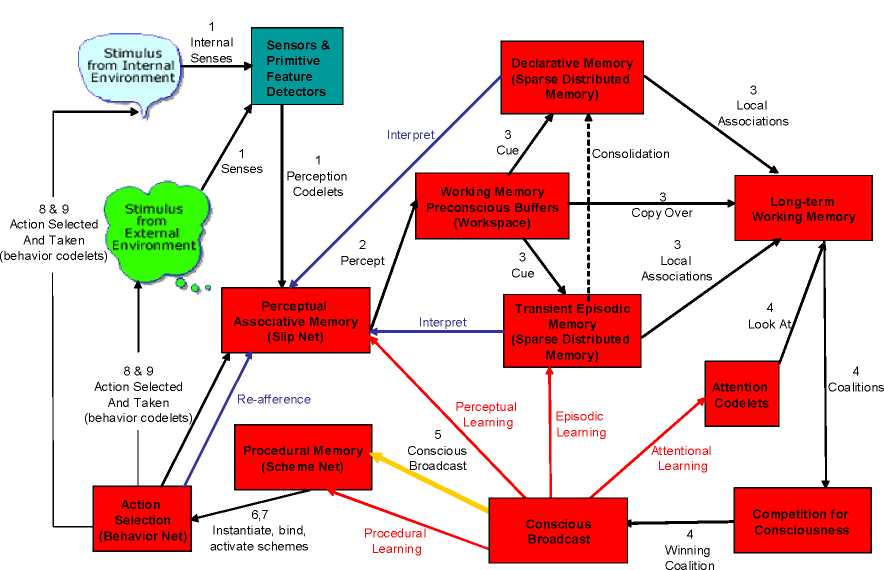
Figure 2: LIDA's Cognitive Cycle
7. Setting Goal Context Hierarchy.
The recruited processors use the contents of
consciousness, including feelings/emotions, to
instantiate new goal context hierarchies, bind
their variables, and increase their activation. It
is here that feelings/emotions directly affect
motivation. They determine which terminal
goal contexts receive activation and how much.
It is here that feelings and emotions most
directly implement motivations by helping to
instantiate and activate goal contexts. Other
environmental conditions determine which of
the earlier goal contexts receive additional
activation.
Schemes with sufficient activation instantiate copies of
themselves in the behavior net with their variables
bound. One of these is a scheme for stepping back into
the classroom.
8. Action Chosen. The behavior net chooses a
single behavior (goal context), perhaps from a
just instantiated behavior stream or possibly
from a previously active stream. This selection
is heavily influenced by activation passed to
various behaviors influenced by the various
feelings/emotions. The choice is also affected
by the current situation, external and internal
conditions, by the relationship between the
behaviors, and by the residual activation values
of various behaviors.
The action scheme to step back into the classroom is
selected.
9. Action Taken. The execution of a behavior
(goal context) results in the behavior codelets
performing their specialized tasks, which may
have external or internal consequences. This is
LIDA taking an action.
The student steps back into the classroom.
The acting codelets also include an expectation
codelet (see Step 6) whose task it is to monitor
the action, and to try and bring to
consciousness any failure in the expected
results.
We suspect that cognitive cycles occur five to ten times
a second in humans, overlapping so that some of the
steps in adjacent cycles occur in parallel (Baars and
Franklin. 2003). Seriality is preserved in the conscious
broadcasts.
More intriguing information
1. The name is absent2. The name is absent
3. The Tangible Contribution of R&D Spending Foreign-Owned Plants to a Host Region: a Plant Level Study of the Irish Manufacturing Sector (1980-1996)
4. Evolution of cognitive function via redeployment of brain areas
5. IMPROVING THE UNIVERSITY'S PERFORMANCE IN PUBLIC POLICY EDUCATION
6. Output Effects of Agri-environmental Programs of the EU
7. Evidence of coevolution in multi-objective evolutionary algorithms
8. The name is absent
9. THE RISE OF RURAL-TO-RURAL LABOR MARKETS IN CHINA
10. The name is absent